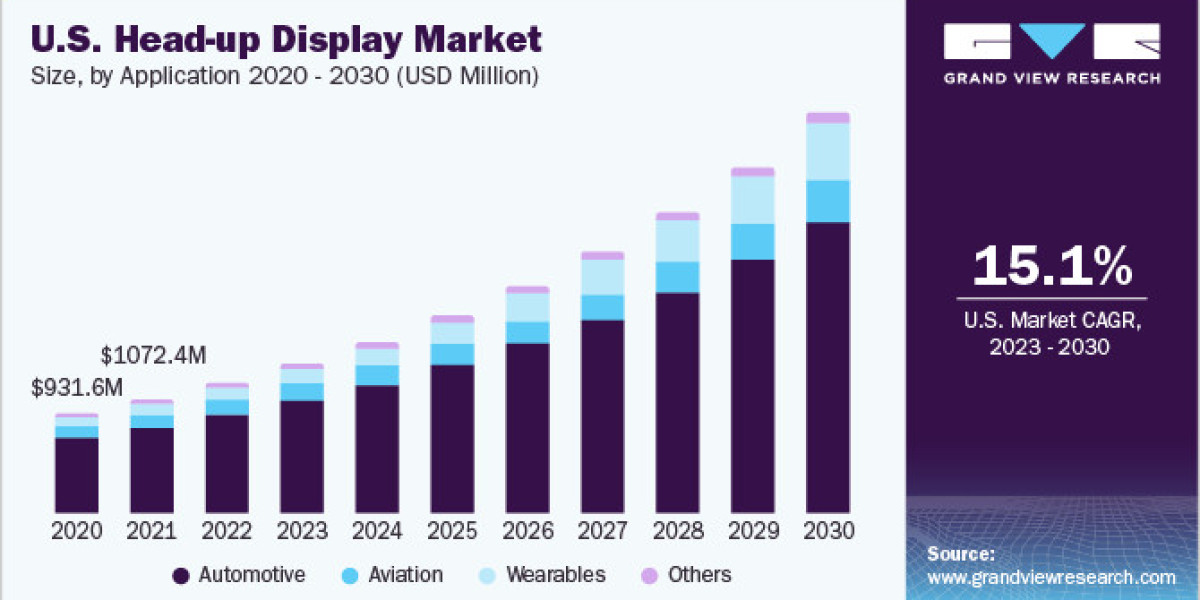The global head-up display (HUD) market was valued at approximately USD 4.75 billion in 2022 and is projected to grow at a compound annual growth rate (CAGR) of 15.7% from 2023 to 2030. The growth in this market is primarily fueled by the affordability of HUD products and their seamless integration with smartphones, which significantly enhances driver safety by minimizing distractions. Additionally, innovative solutions such as global positioning systems (GPS) and augmented reality (AR) are increasingly being integrated into HUD systems, further propelling market demand. HUD technology, which presents information in the driver’s line of sight without requiring them to divert their attention from the road, was originally developed for aviation and military applications but is now being widely adopted in automobiles, commercial aircraft, and various wearable devices.
Gather more insights about the market drivers, restrains and growth of the Global Head-Up Display Market
Impact of Economic Factors
The rising purchasing power of individuals, driven by increased disposable incomes, is expected to further boost the growth of the HUD market. The modern consumer demographic is becoming more tech-savvy and increasingly receptive to advanced technological products that enhance safety while driving. Moreover, there is a growing awareness regarding road safety, which is a significant factor contributing to the market's expansion.
Product Components and Functionality
A typical head-up display system consists of several components, including a projector unit, a display system, a programmed computer, and connecting cables. HUDs come in various forms, such as fixed-mounted and helmet-mounted systems, providing innovative ways to view navigation directions. These systems can also be integrated with adaptive cruise control, a recent advancement in automotive transport technology, to enhance safety features.
The improved living standards globally have led to greater affordability of premium vehicles, consequently increasing the use of HUDs for navigation. Although many automobile manufacturers offer HUD systems as optional features, there is a growing trend suggesting that such systems may soon become standard across all vehicle models to enhance safety and improve user experience.
Segmentation Analysis:
Application Insights
The HUD market is segmented based on applications, which include automotive, aviation, wearables, and others. Within the automotive sector, there are further distinctions between premium/luxury, sports, and basic/mid-range cars. The automotive segment accounted for the largest revenue share, approximately 77.2%, in 2022. The increasing integration of HUDs with driver assistance systems—adopted by numerous automobile manufacturers—is anticipated to drive market growth. Additionally, rapid technological advancements and the incorporation of artificial intelligence (AI) in automotive systems are significant factors influencing market expansion.
Wearables and Aviation Growth
The wearables segment is projected to experience the fastest CAGR of 20.2% during the forecast period. This growth is driven by substantial investments in research and development from vendors aiming to enhance the driving experience. The rising demand for advanced technology that provides improved accuracy is a key factor propelling the growth of HUDs in the wearable sector.
The aviation segment is also expected to see significant growth over the forecast period, as many commercial aircraft are implementing HUD systems for optimal landing and takeoff. Additionally, the increasing number of flight simulators is driving market growth. However, creating transparent displays that offer enhanced visibility in both sunlight and nighttime conditions presents a major challenge for manufacturers.
Regional Insights: North America
North America led the market, holding the largest revenue share of 30.3% in 2022. Key factors driving growth in this region include the presence of major technology companies and significant investments in R&D for head-up display systems. Recent technological innovations within the automotive industry, such as adaptive cruise control and augmented reality features, are notable trends expected to significantly boost demand in the U.S. market. Furthermore, North America, as one of the largest automotive markets globally, is poised to contribute substantially to overall market revenue.
Asia Pacific
The Asia Pacific region is anticipated to exhibit the highest CAGR of 17.4% during the forecast period. This growth is attributed to increasing awareness among consumers about the advantages of HUD technology. Additionally, improvements in living standards and rising disposable incomes are key factors driving market expansion in this region.
Order a free sample PDF of the Head-Up Display Market Intelligence Study, published by Grand View Research.







